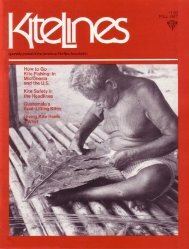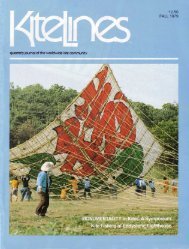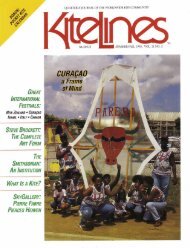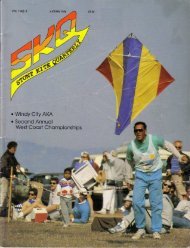Untitled - KiteLife
Untitled - KiteLife
Untitled - KiteLife
- No tags were found...
You also want an ePaper? Increase the reach of your titles
YUMPU automatically turns print PDFs into web optimized ePapers that Google loves.
Team flying tips, and gadgetsare the subject of this SHORT LINES .No gabbing, get right down tobusiness .(From Rod Yarger, Yakima, Wash.)If you appreciate the frictionlesscontrol given by the "Spectra"fiber lines, but suffer burn-throughfrom the low melting point of theline, consider this . When a teammember's luff-tape covered leadingedge brushes your lines, it'seither going to melt through orweaken your line due to the heatgenerated from the friction . Trythe best of both worlds, and splice15'-20' lengths of kevlar to the endof your lines. The Kevlar won'tmelt, and it may save you from anembarrassing line mend during ateam routine when everyone'seyes are on you . Just don't overdothe length of the Kevlar sectionsand splice them too close tothe point where the multiple linestwist and wrap around each otherduring spins and multiple kitewraps .(Al's Note : Some 1989 competitionevents across the countrymay restrict team and individualline lengths . e .g . WCSKC - 100ft .)Another suggestion to changethe speed of team kites to shortenthe top spreader of each of thetrailing kites by 1/4" (2nd kite 1/4"shorter, 3rd kite 1/2" shorter and soforth . Shorter for slower kites .)(From Ron Fikes, Palo Alto, Ca .)I like flying Flexifoils, but the fieldwhere I fly has stickery weeds, sothe need for a solo launchingdevice that will hold the kite up,inflated and ready to take to theair. My system makes "Duck Soup"of this . (See photo below .) The reassembledclothespins on the"ducks" hold the 'foil spar tips offthe ground . Keeps the kite fromgoing up or back while facingright into the wind (inflated) andwhen ready, a sharp pull and thekite is off and flying . The spikesthrough the "ducks" can bemade longer, if needed, for deepweeds . The only problem I havehad this device is to keep my fellowfliers from stealing the "ducks ."(After I sent a reply complementingRon on his "ducks" heblasted back two more "ShortLines")I found out right away thatsomething needed to be doneabout the "nocks" on my Spin-off- when flying in the dirt they weretaking a beating . Filled with sticks,grass, stones, and dirt from all thelandings . So I made "Nock Protectors"or "Training Wheels ."Buy a piece of 1/16" wall, 1/2 " I .D .vinyl tubing and cut two piecesthree inches long . One inch fromthe end, punch a hole throughboth sides . Using a heavy threador twine, lace the line through thevinyl twice and tie with a coupleof square knots .To install the "Protectors" onyour kite, rig as usual and afterputting on the shock cords overthe nocks, slip the vinyl tubingOVER the shock cord and thenock with the 2" portion towardsthe fabric . The cord that goes(From Dan Wheeler of PrecisionKite Co . of Rhode Island)Make sure that your team kitesmatch in speed . Lines should bestaggered about three feet withthe lead kite being the longest .Minor bridle adjustments can helpcorrect small differences in kitespeed, but be careful not tochange the turning ability of thekites in the process . Try flying on200ft . team lines, as this gives theteam more space to maneuver in .
















